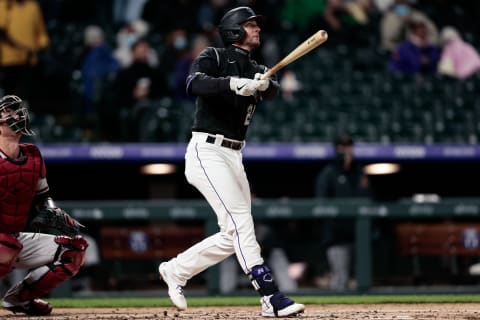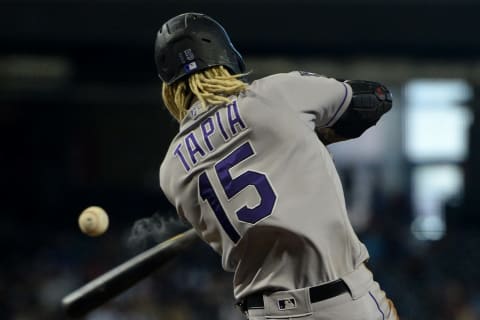Colorado Rockies: How Raimel Tapia can learn from Ryan McMahon’s offseason adjustments


One of the best parts about this paltry 2021 season for the Colorado Rockies has been seeing the jump that Ryan McMahon has made as a hitter.
He has made some key adjustments in his approach that have been applied fantastically to his hitting profile and it’s resulting in much more positive results for him in years past, making him a threat both at Coors and on the road (something this year’s Rockies are obviously struggling with). It’s a welcome sight to see from someone who will need to be a large presence on this Rockies roster in the coming years.
Raimel Tapia, on the mean hand, has seemingly started to take a bit of a step back from his 2020 numbers and is hitting eerily similar to his 2019 season in terms of advanced stats. As I dug into the stats more and analyzed his hitting profile, I recognized many things he’s doing this year that were similar to what McMahon was doing last season and I believe there’s a very straightforward way to help Tapia improve as a hitter in the coming years.
With two more years of arbitration before Tapia becomes an unrestricted free agent, he will need to improve as a hitter to maximize his value and the answer is within Ryan McMahon‘s adjustments he’s made this season.
Here are the lessons Raimel Tapia could learn from his Colorado Rockies teammate, Ryan McMahon.

First, let’s start by examining Raimel Tapia’s numbers so far this year for the Colorado Rockies (entering Friday):
Slash Line: .270/.323/.377
HR: 5
wRC+: 79
wOBA: .305
xwOBA: .285
BABIP: .294
BB%: 7.6%
K%: 13.9%
fWAR: 0.1
Now, let’s compare that to what he posted in 2020 (51 games):
Slash Line: .321/.369/.402
HR: 1
wRC+: 96
wOBA: .338
xwOBA: .290
BABIP: .392
BB%: 6.8%
K%: 18.4%
fWAR: 0.7
There are a couple of big things to notice here.
First, that K% has dropped from 18.4 percent to 13.9 percent. In general, that’s a really good thing to see that he’s cut down on his Ks. He wasn’t striking out a ton before, but he’s getting the bat on the ball more often. That can be both good and bad.
The next biggest difference that we see is that near 100 point drop in BABIP. If you’re unfamiliar with BABIP, that is simply one’s Batting Average on Balls In Play.
Generally, if you’re a speedy guy, like Tapia, then you’re going to have a higher BABIP because you’ll beat out more infield ground balls than a normal hitter. A league-average BABIP is going to be around .300 or so. Tapia’s got a career BABIP of .342, so the massive drop to make his numbers slightly below league average should be concerning given where he normally is. There’s a large contributor to that stat this season for him, but we’ll get into that later.
The next stat we really need to look at is that drop in wRC+. Last season, Tapia put up a wRC+ of 96, meaning he was a near-league-average hitter. This year it’s down to 79. That near 20 percent drop puts him right in line with his career average wRC+ of 78.
For someone like Tapia who showed more promise in his opportunities last year, why is he down this year?

The answer to that question is fairly simply for the Colorado Rockies left fielder.
While he’s been really good at limiting his strikeouts by putting balls in play, he’s not doing so in effective ways. Most noticeably, he’s hitting ground balls at a 61.5 percent clip.
That ranks as 2nd most in the majors among qualified hitters behind only Pittsburgh’s Erik Gonzalez, who’s hitting for a wRC+ of a lowly 47. It doesn’t mean you can’t succeed this way, you just need to be excellent in other areas.
Tim Anderson of the Chicago White Sox has the 3rd highest GB% at 61.4 percent, but he’s excelling in many other ways with his bat and is hitting for a wRC+ of 117.
Tapia simply hasn’t yet.
For Tapia, that GB% would be a career-high if it sticks.
It’s nearly six percent higher than his 2020 number. It’s even gotten so high that Tapia now has a negative Launch Angle (-0.5). Now, a successful Launch Angle is going to differ for every hitter dependent on their strengths, and no one launch angle is the best, but it’s getting to a concerning point here.
In fact, when you consider Tapia’s launch angle (-0.5), his GB% (61.5 percent) his HR/FB% (14.7 percent) and his Hard Hit% (31.4 percent), it actually reads incredibly similarly to a former teammate of his.

Ian Desmond’s 2017 season (0.0 Launch Angle, 62.7 GB%, 13.2 HR/FB%, 30.6 Hard Hit%).
People always ragged on Desmond for his deficiencies hitting with the Rockies but Tapia’s profile so far this season is very similar to that dreadful 2017 season that Desmond had.
Now, let’s go back to one of those stats: HR/FB%. Tapia’s number stands at 14.7 percent. That would be a career-high for him and it signifies one very important thing: When he hits the ball in the air, he hits it well.
The 14.7% number isn’t phenomenal, but it puts him in the company of other decent hitters so far this season: Randy Arozarena of Tampa Bay (115 wRC+), Yoan Moncada of the Chicago White Sox (153 wRC+), Pete Alonso of the New York Mets (122 wRC+) and Josh Donaldson of the Minnesota Twins (126 wRC+).
Now, all of those hitters are different types of hitters than Tapia so the comparison isn’t quite apples to apples. Tim Anderson is the best current comparison for Tapia’s batting profile and Anderson has a HR/FB% of 24%. But each of those hitters have a wRC+ above 100 and none of that is a mistake. When they put the ball in the air, they punish it. Tapia has room for improvement.
In fact, this is why I believe Ryan McMahon’s adjustments that he made are the key to making Tapia a better and more valuable overall hitter.

In 2020, here’s what Ryan McMahon’s hitting profile looked like (52 Games):
Slash Line: .215/.295/.419
HR: 9
wRC+: 76
wOBA: .308
xwOBA: .293
BABIP: .286
BB%: 9.3%
K%: 34.2%
fWAR: 0.1
And here’s what he’s done so far in 2021 (56 games):
Slash Line: .259/.313/.507
HR: 13
wRC+: 106
wOBA: .346
xwOBA: .361
BABIP: .280
BB%: 7.6%
K%: 22.8%
fWAR: 1.3
More from Rox Pile
- A Colorado Rockies Thanksgiving
- Colorado Rockies: What if Todd Helton had played football instead?
- Colorado Rockies: Charlie Blackmon out for the season
- Colorado Rockies: Injuries shift look of roster ahead of Dodgers series
- Colorado Rockies: Has Sean Bouchard earned a second look in 2023?
Now, a huge chunk of what he’s done better this season is relative to that K%. He’s cut down a ton on that number and that’s been pretty huge to his success. It doesn’t always mean everyone’s success, a la Tapia’s numbers while cutting down on Ks, but it’s helping McMahon.
It’s not the only contributor to him performing better, though. See that positive increase in nearly all his numbers besides BABIP? Outside of cutting down on Ks, there’s one main reason he’s becoming more successful.
In both 2020 and 2019, he had a GB% over 50 percent. In 2021, he’s cut that down to 32.3 percent. He is, for the first time in his career, hitting more fly balls than he is ground balls.
Why?
Because he CRUSHES the ball in the air. His HR/FB% has dropped as a result of hitting more balls in the air, which will be natural, but he’s getting much, much better results.
In just 4 more games this season compared to last season, he has seven more singles (28 vs 21), six more doubles (12 vs 6) and 4 more HRs (13 vs 9). His Hard Hit% has increased and his Launch Angle has doubled.
What this all shows is pretty simple: Ryan McMahon recognized that when he hits the ball in the air he gets much, much better results, so he made a concerted effort to adjust his swing and start hitting the ball in the air more often. And look at the results!
He’s still not a world-beater by any means, but it’s a significant improvement he’s made in just one season. What’s incredible about it too is that his xwOBA (Expected Weighted On Base Average) is HIGHER than his wOBA, meaning there’s a very good likelihood that he’s been a bit unlucky this season also.

So the plan for Tapia should be pretty simple: Follow in the footsteps of Ryan McMahon and make a concerted effort to hit the ball in the air more often.
However, his swing needs to adjust to appropriately accommodate that change. But Tapia needs to make a concerted effort to hit the ball in the air much more often. If he does so, more positive results will come. Even if it results in a higher K% than it currently is (which isn’t always a bad thing) it could take away from easy outs and result in more line drives and HRs.
And hey! If he does so and he becomes a better hitter, he becomes more valuable to the Rockies and that means more $$$ for him in arbitration or in 2024 when he becomes an unrestricted free agent.
Next. If Tapia doesn't lead off, who would replace him?. dark
Tapia will be a part of this team for the foreseeable future. For his future success, and the Rockies’ future success, it’s best for him to emulate Ryan McMahon and his strategies as they are clearly working well for him.